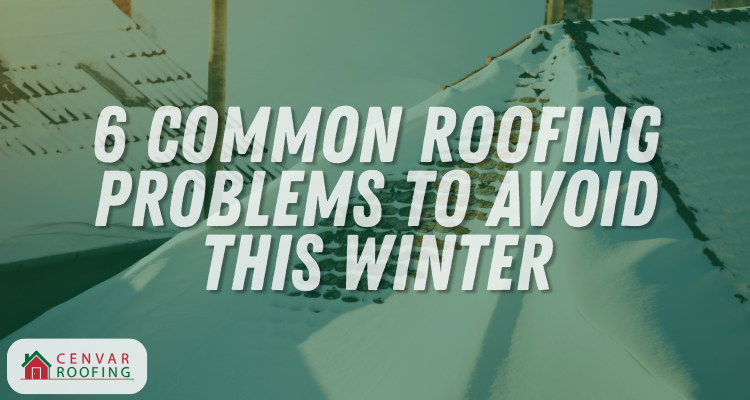- 1-905-452-8193
- Contact Us
- Member Login
- Get Listed Today
- 220,911 members

In winter, your home should be a haven of warmth, safety, and security. One of the key components in maintaining the warmth and protection of your home is your roof, which faces unique challenges during this season.
To keep your home in top-notch condition during winter storms, homeowners need to be aware of common roofing issues and take preventive measures. Neglecting these issues or failing to prevent them could have you looking at a total roof replacement in Roanoke sooner than you’d like.
Let's explore six of the most common roofing problems and the steps you can take to ensure your roof and home stay in excellent shape throughout winter.
Excess moisture in your home's air can lead to condensation, a process where warm, moist air rises and meets the cooler air in the attic. When this happens, the moisture in the warm air transforms into mist or water droplets. Interestingly, this dripping water is sometimes misunderstood as a leak.
If this excess moisture is not addressed, it can seep into the attic, potentially causing water damage and eventually leading to wood rot in the sheathing, wall studs, floor joists, ceiling rafters, and elsewhere.
Prevention: Addressing condensation issues related to your roof is often as simple as ensuring proper insulation in your attic. This helps to keep the warm air inside your home from escaping into the attic space. If you think your home might lack sufficient attic insulation, it's a good idea to get it checked by a professional.
In wintertime, a common cause of roof leaks is faulty chimney flashing.
Chimney flashing is a metal strip that seals the area where the chimney meets the roofing material, its function is to keep water from seeping in through seams and cracks. To spot these leaks, examine the space around the chimney for water damage clues—both in the attic and outside on the roof.
Prevention: Inspecting the caulking around your chimney's flashing is a crucial step to avoid leaks when winter arrives. Before the cold season starts, it's important to check for cracks or erosion in the caulking. If you notice any damage, a straightforward chimney repair can usually fix the issue.
When autumn arrives, leaves fall and find their way into gutters and corners on rooftops. If these leaves stay on the roof, they can gather moisture and may eventually cause leaks in the shingles below.
Gutters filled with leaves can get blocked, causing water to accumulate and eventually spill over onto the roof. This can result in water damage, eventually requiring a roof repair.
Prevention: To keep your home in top shape and avoid troubles caused by leaves, make sure to wait until all the leaves have fallen before you start cleaning. This ensures that you won't have to repeat the process. The most straightforward solution is to clean both your roof and gutters. This not only prevents potential problems but also makes maintenance easier.
Winter can be risky for your home if there are tree branches hanging low near your roof. When storms hit, snow and ice can accumulate on these branches, making them heavier. Eventually, they might snap and fall onto your roof, leading to potential damage. The impact could be strong enough to break shingles, dent metal, or even cause part of your roof to collapse.
Prevention: One simple way to avoid potential issues is by trimming the branches that hang low over your roof before the winter season arrives. This proactive step can make a big difference in protecting your home.
These icy ridges pose a threat to the integrity of your roof and can lead to serious issues. Ice dams are ridges of ice that develop along the edge of the roof. The main culprit behind their formation is insufficient attic insulation. Inadequate attic insulation allows warm air from inside the house to escape into the attic, which in turn warms the roof, causing snow on the roof to melt.
The melted snow travels down the roof but, when it reaches the roof edge, it's no longer warmed by the attic. Unable to drain into the gutters, the water refreezes, forming an ice dam. Once an ice dam takes hold, the normal drainage of snowmelt is disrupted. Instead of flowing off the roof, the trapped water backs up and finds its way under the shingles. The consequences can be severe, causing damage to both the interior and exterior of your home.
Prevention: Preventing ice dams is all about adequate attic insulation. Once an ice dam has formed, you can repeatedly spray the area with warm water or use a chemical ice melt on the ice ridges. Call in a roofing professional to help if the task becomes too daunting or dangerous.
When a large amount of snow accumulates on a roof following a significant snowstorm, it can exceed the roof's weight-bearing capacity, leading to the roof collapsing. The danger becomes even greater if there is both snow and ice buildup.
Prevention: When you see over a foot of snow piling up on your roof, it's time to remove it. You can use a roof rake or heavy broom to clear it away. Do not walk on the roof, stay on the ground when removing snow from the roof to avoid slipping and making it unsafe to walk on.
By understanding these common issues and taking proactive steps, you can ensure that your roof remains resilient against the winter elements, providing a warm and secure shelter for you and your family.
